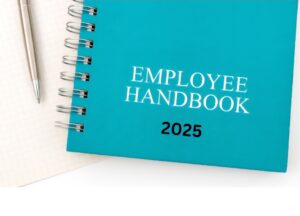Learn what policies are mandated for 2025 and avoid costly mistakes.
Common mistakes when updating an employee handbook for 2025
Using outdated templates
Failing to customize for local and state laws
Overlooking new legislation on paid leave and AI policies
These errors can expose you to legal action, penalties, and employee lawsuits.
Fatal errors to avoid when updating employee handbooks
1) Assuming a “one-size-fits-all” approach
What’s wrong: Generic boilerplate handbooks from the internet can be non-compliant across states.
The risk: Laws change; a policy compliant in one state may be illegal in another.
Best practice: Draft a custom handbook and create state/local addendums for each location (important with remote/hybrid work).
2) Failing to include a clear “at-will” disclaimer
What’s wrong: Promising job security or implying a contract can override at-will employment.
The risk: A court could interpret language as a binding contract, risking wrongful termination claims.
Best practice: Include a clear disclaimer that the handbook is not an employment contract and that employment is at-will. Have employees acknowledge the disclaimer.
3) Creating overly rigid or restrictive policies
What’s wrong: Prescriptive policies can impede managers from assessing unique situations.
The risk: A strict disciplinary process can be used against you if you need to tailor steps for serious infractions.
Best practice: Build flexibility into disciplinary policies; state that the company can make situational judgments and skip steps when necessary.
4) Overlooking NLRA issues
What’s wrong: Rules about conduct, confidentiality, and social media can unlawfully interfere with proscribed employee rights to discuss wages and conditions.
The risk: The NLRB may deem broad policies unlawful, even in non-union shops.
Best practice: Review policies that could restrict protected conversations about work conditions; follow updated NLRB guidance.
5) Inconsistently enforcing policies
What’s wrong: A written policy without consistent application undermines credibility.
The risk: Claims of discrimination or unfair treatment.
Best practice: Train managers and supervisors on new policies before roll-out; ensure fair, consistent application.
6) Failing to get signed employee acknowledgements
What’s wrong: Distribution without proof of receipt/review is ineffective.
The risk: An employee may claim ignorance, weakening your defense.
Best practice: Require signed, dated acknowledgement for the updated handbook and securely store in the personnel file.
Mandated policies and updates for 2025
Anti-harassment and non-discrimination policies
Expand protected classes (e.g., gender identity, sexual orientation, CROWN Act protections for natural hair, disability accommodations).
Clear reporting procedures and protections from retaliation.
Include PWFA (Pregnant Workers Fairness Act) accommodations.
Paid leave policies
Stay current with state/local paid sick leave and family leave laws.
California example: Paid sick leave increased from 3 to 5 days (as of 2024).
Reproductive loss leave: Some jurisdictions require leave for reproductive loss events.
Action: Review state laws on paid time off, mental health days, and caregiving leave.
Wage and hour policies
Overtime exemptions: Check FLSA salary thresholds for exempt employees.
Pay transparency: Some states/localities require salary ranges in postings.
Timekeeping for remote workers: Clear guidelines for timekeeping and business expense reimbursement.
Technology and AI usage policies
Usage guidelines: Define acceptable AI use to protect confidential information and data privacy.
Hiring processes: Some jurisdictions (e.g., NYC) require bias audits for AI in hiring decisions.
Monitoring: Include transparent policies on monitoring online activity or company device usage.
Remote and hybrid work policies
State-specific compliance: Align with labor laws of each state where employees work.
Expectations: Define availability, communication, and work hours for remote workers.
Equipment: Outline company-provided devices, IT support, and cybersecurity requirements.
Quick checklist for 2025 handbook updates
[ ] Create a custom handbook with state/local addendums
[ ] Include a clear at-will disclaimer with employee acknowledgement
[ ] Build in policy flexibility for disciplinary actions
[ ] Review NLRA-related language; ensure no unlawful restrictions on discussion of wages/conditions
[ ] Implement mandatory training for managers on new policies
[ ] Require signed acknowledgements stored in personnel files
[ ] Update anti-harassment, non-discrimination, and PWFA compliance
[ ] Align paid leave with state/local rules; include reproductive loss leave where required
[ ] Update wage/hour provisions: exemptions, pay transparency, timekeeping
[ ] Establish AI usage, bias audit, and monitoring policies
[ ] Adapt remote/hybrid policies to multi-state requirements

